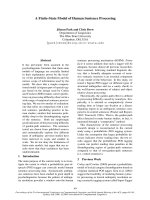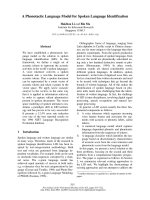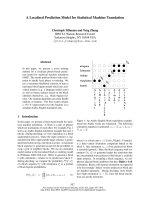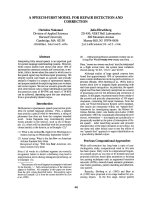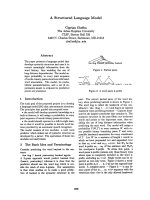Báo cáo khoa học: "A Joint Source-Channel Model for Machine Transliteration" doc
Bạn đang xem bản rút gọn của tài liệu. Xem và tải ngay bản đầy đủ của tài liệu tại đây (227.2 KB, 8 trang )
A Joint Source-Channel Model for Machine Transliteration
Li Haizhou, Zhang Min, Su Jian
Institute for Infocomm Research
21 Heng Mui Keng Terrace, Singapore 119613
{hli,sujian,mzhang}@i2r.a-star.edu.sg
Abstract
Most foreign names are transliterated into
Chinese, Japanese or Korean with
approximate phonetic equivalents. The
transliteration is usually achieved through
intermediate phonemic mapping. This
paper presents a new framework that
allows direct orthographical mapping
(DOM) between two different languages,
through a joint source-channel model, also
called n-gram transliteration model (TM).
With the n-gram TM model, we automate
the orthographic alignment process to
derive the aligned transliteration units from
a bilingual dictionary. The n-gram TM
under the DOM framework greatly reduces
system development effort and provides a
quantum leap in improvement in
transliteration accuracy over that of other
state-of-the-art machine learning
algorithms. The modeling framework is
validated through several experiments for
English-Chinese language pair.
1 Introduction
In applications such as cross-lingual information
retrieval (CLIR) and machine translation, there is
an increasing need to translate out-of-vocabulary
words from one language to another, especially
from alphabet language to Chinese, Japanese or
Korean. Proper names of English, French,
German, Russian, Spanish and Arabic origins
constitute a good portion of out-of-vocabulary
words. They are translated through transliteration,
the method of translating into another language by
preserving how words sound in their original
languages. For writing foreign names in Chinese,
transliteration always follows the original
romanization. Therefore, any foreign name will
have only one Pinyin (romanization of Chinese)
and thus in Chinese characters.
In this paper, we focus on automatic Chinese
transliteration of foreign alphabet names. Because
some alphabet writing systems use various
diacritical marks, we find it more practical to write
names containing such diacriticals as they are
rendered in English. Therefore, we refer all
foreign-Chinese transliteration to English-Chinese
transliteration, or E2C.
Transliterating English names into Chinese is
not straightforward. However, recalling the
original from Chinese transliteration is even more
challenging as the E2C transliteration may have
lost some original phonemic evidences. The
Chinese-English backward transliteration process
is also called back-transliteration, or C2E (Knight
& Graehl, 1998).
In machine transliteration, the noisy channel
model (NCM), based on a phoneme-based
approach, has recently received considerable
attention (Meng et al. 2001; Jung et al, 2000; Virga
& Khudanpur, 2003; Knight & Graehl, 1998). In
this paper we discuss the limitations of such an
approach and address its problems by firstly
proposing a paradigm that allows direct
orthographic mapping (DOM), secondly further
proposing a joint source-channel model as a
realization of DOM. Two other machine learning
techniques, NCM and ID3 (Quinlan, 1993)
decision tree, also are implemented under DOM as
reference to compare with the proposed n-gram
TM.
This paper is organized as follows: In section 2,
we present the transliteration problems. In section
3, a joint source-channel model is formulated. In
section 4, several experiments are carried out to
study different aspects of proposed algorithm. In
section 5, we relate our algorithms to other
reported work. Finally, we conclude the study with
some discussions.
2 Problems in transliteration
Transliteration is a process that takes a character
string in source language as input and generates a
character string in the target language as output.
The process can be seen conceptually as two levels
of decoding: segmentation of the source string into
transliteration units; and relating the source
language transliteration units with units in the
target language, by resolving different
combinations of alignments and unit mappings. A
unit could be a Chinese character or a monograph,
a digraph or a trigraph and so on for English.
2.1 Phoneme-based approach
The problems of English-Chinese transliteration
have been studied extensively in the paradigm of
noisy channel model (NCM). For a given English
name E as the observed channel output, one seeks
a posteriori the most likely Chinese transliteration
C that maximizes P(C|E). Applying Bayes rule, it
means to find C to maximize
P(E,C) = P(E | C)*P(C) (1)
with equivalent effect. To do so, we are left with
modeling two probability distributions: P(E|C), the
probability of transliterating C to E through a noisy
channel, which is also called transformation rules,
and P(C), the probability distribution of source,
which reflects what is considered good Chinese
transliteration in general. Likewise, in C2E back-
transliteration, we would find E that maximizes
P(E,C) = P(C | E)*P(E) (2)
for a given Chinese name.
In eqn (1) and (2), P(C) and P(E) are usually
estimated using n-gram language models (Jelinek,
1991). Inspired by research results of grapheme-to-
phoneme research in speech synthesis literature,
many have suggested phoneme-based approaches
to resolving P(E|C) and P(C|E), which
approximates the probability distribution by
introducing a phonemic representation. In this way,
we convert the names in the source language, say
E, into an intermediate phonemic representation P,
and then convert the phonemic representation into
the target language, say Chinese C. In E2C
transliteration, the phoneme-based approach can be
formulated as P(C|E) = P(C|P)P(P|E) and
conversely we have P(E|C) = P(E|P)P(P|C) for
C2E back-transliteration.
Several phoneme-based techniques have been
proposed in the recent past for machine
transliteration using transformation-based learning
algorithm (Meng et al. 2001; Jung et al, 2000;
Virga & Khudanpur, 2003) and using finite state
transducer that implements transformation rules
(Knight & Graehl, 1998), where both handcrafted
and data-driven transformation rules have been
studied.
However, the phoneme-based approaches are
limited by two major constraints, which could
compromise transliterating precision, especially in
English-Chinese transliteration:
1) Latin-alphabet foreign names are of different
origins. For instance, French has different phonic
rules from those of English. The phoneme-based
approach requires derivation of proper phonemic
representation for names of different origins. One
may need to prepare multiple language-dependent
grapheme-to-phoneme (G2P) conversion systems
accordingly, and that is not easy to achieve (The
Onomastica Consortium, 1995). For example,
/Lafontant/ is transliterated into 拉丰唐(La-Feng-
Tang) while /Constant/ becomes 康斯坦特(Kang-
Si-Tan-Te) , where syllable /-tant/ in the two
names are transliterated differently depending on
the names’ language of origin.
2) Suppose that language dependent grapheme-
to-phoneme systems are attainable, obtaining
Chinese orthography will need two further steps: a)
conversion from generic phonemic representation
to Chinese Pinyin; b) conversion from Pinyin to
Chinese characters. Each step introduces a level of
imprecision. Virga and Khudanpur (2003) reported
8.3% absolute accuracy drops when converting
from Pinyin to Chinese characters, due to
homophone confusion. Unlike Japanese katakana
or Korean alphabet, Chinese characters are more
ideographic than phonetic. To arrive at an
appropriate Chinese transliteration, one cannot rely
solely on the intermediate phonemic representation.
2.2 Useful orthographic context
To illustrate the importance of contextual
information in transliteration, let’s take name
/Minahan/ as an example, the correct segmentation
should be /Mi-na-han/, to be transliterated as 米-
纳-汉 (Pinyin: Mi-Na-Han).
English /mi- -na- -han/
Chinese
米 纳 汉
Pinyin
Mi Nan Han
However, a possible segmentation /Min-ah-an/
could lead to an undesirable syllabication of 明-
阿-安 (Pinyin: Min-A-An).
English /min- -ah- -an/
Chinese
明 阿 安
Pinyin
Min A An
According to the transliteration guidelines, a
wise segmentation can be reached only after
exploring the combination of the left and right
context of transliteration units. From the
computational point of view, this strongly suggests
using a contextual n-gram as the knowledge base
for the alignment decision.
Another example will show us how one-to-many
mappings could be resolved by context. Let’s take
another name /Smith/ as an example. Although we
can arrive at an obvious segmentation /s-mi-th/,
there are three Chinese characters for each of /s-/,
/-mi-/ and /-th/. Furthermore, /s-/ and /-th/
correspond to overlapping characters as well, as
shown next.
English /s- -mi- -th/
Chinese 1
史
米
斯
Chinese 2
斯
密
史
Chinese 3
思 麦 瑟
A human translator will use transliteration rules
between English syllable sequence and Chinese
character sequence to obtain the best mapping
史
-
密
-
斯
, as indicated in italic in the table above.
To address the issues in transliteration, we
propose a direct orthographic mapping (DOM)
framework through a joint source-channel model
by fully exploring orthographic contextual
information, aiming at alleviating the imprecision
introduced by the multiple-step phoneme-based
approach.
3 Joint source-channel model
In view of the close coupling of the source and
target transliteration units, we propose to estimate
P(E,C) by a joint source-channel model, or n-gram
transliteration model (TM). For K aligned
transliteration units, we have
) ,, ,(),(
2121 KK
ccceeePCEP =
), ,,,(
21 K
cececeP ><><><= (3)
∏
=
−
><><=
K
k
k
k
ceceP
1
1
1
),|,(
which provides an alternative to the phoneme-
based approach for resolving eqn. (1) and (2) by
eliminating the intermediate phonemic
representation.
Unlike the noisy-channel model, the joint
source-channel model does not try to capture how
source names can be mapped to target names, but
rather how source and target names can be
generated simultaneously. In other words, we
estimate a joint probability model that can be
easily marginalized in order to yield conditional
probability models for both transliteration and
back-transliteration.
Suppose that we have an English name
m
xxx
21
=
α
and a Chinese transliteration
n
yyy
21
=
β
where
i
x are letters and
j
y are
Chinese characters. Oftentimes, the number of
letters is different from the number of Chinese
characters. A Chinese character may correspond to
a letter substring in English or vice versa.
mii
xxxxxxx
21321 ++
nj
yyyy
21
where there exists an alignment
γ
with
>=<>
<
111
,, yxce
>
=
<>
<
2322
,, yxxce …
and
>
=
<>
<
nmK
yxce ,, . A transliteration unit
correspondence
>
<
ce, is called a transliteration
pair. Then, the E2C transliteration can be
formulated as
),,(maxarg
,
γβαβ
γβ
P= (4)
and similarly the C2E back-transliteration as
),,(maxarg
,
γβαα
γα
P= (5)
An n-gram transliteration model is defined as the
conditional probability, or transliteration
probability, of a transliteration pair
k
ce >
<
,
depending on its immediate n predecessor pairs:
),,(),(
γ
β
α
PCEP
=
∏
=
−
+−
><><=
K
k
k
nkk
ceceP
1
1
1
),|,(
(6)
3.1 Transliteration alignment
A bilingual dictionary contains entries mapping
English names to their respective Chinese
transliterations. Like many other solutions in
computational linguistics, it is possible to
automatically analyze the bilingual dictionary to
acquire knowledge in order to map new English
names to Chinese and vice versa. Based on the
transliteration formulation above, a transliteration
model can be built with transliteration unit’s n-
gram statistics. To obtain the statistics, the
bilingual dictionary needs to be aligned. The
maximum likelihood approach, through EM
algorithm (Dempster, 1977), allows us to infer
such an alignment easily as described in the table
below.
The aligning process is different from that of
transliteration given in eqn. (4) or (5) in that, here
we have fixed bilingual entries,
α
and
β
. The
aligning process is just to find the alignment
segmentation
γ
between the two strings that
maximizes the joint probability:
),,(maxarg
γβαγ
γ
P= (7)
A set of transliteration pairs that is derived from
the aligning process forms a transliteration table,
which is in turn used in the transliteration
decoding. As the decoder is bounded by this table,
it is important to make sure that the training
database covers as much as possible the potential
transliteration patterns. Here are some examples of
resulting alignment pairs.
斯|s 尔|l 特|t 德|d
克|k 布|b 格|g 尔|r
尔|ll 克|c 罗|ro 里|ri
曼|man 姆|m 普|p 德|de
拉|ra 尔|le 阿|a 伯|ber
拉|la 森|son 顿|ton 特|tt
雷|re 科|co 奥|o 埃|e
马|ma 利|ley 利|li 默|mer
Knowing that the training data set will never be
sufficient for every n-gram unit, different
smoothing approaches are applied, for example, by
using backoff or class-based models, which can be
found in statistical language modeling literatures
(Jelinek, 1991).
3.2 DOM: n-gram TM vs. NCM
Although in the literature, most noisy channel
models (NCM) are studied under phoneme-based
paradigm for machine transliteration, NCM can
also be realized under direct orthographic mapping
(DOM). Next, let’s look into a bigram case to see
what n-gram TM and NCM present to us. For E2C
conversion, re-writing eqn (1) and eqn (6) , we
have
∏
=
−
≈
K
k
kkkk
ccPcePP
1
1
)|()|(),,(
γβα
(8)
),,(
γ
β
α
P ),|,(
1
1
−
=
><><≈
∏
kk
K
k
ceceP (9)
The formulation of eqn. (8) could be interpreted
as a hidden Markov model with Chinese characters
as its hidden states and English transliteration units
as the observations (Rabiner, 1989). The number
of parameters in the bigram TM is potentially
2
T
,
while in the noisy channel model (NCM) it’s
2
CT + , where
T
is the number of transliteration
pairs and
C is the number of Chinese
transliteration units. In eqn. (9), the current
transliteration depends on both Chinese and
English transliteration history while in eqn. (8), it
depends only on the previous Chinese unit.
As
22
CTT +>> , an n-gram TM gives a finer
description than that of NCM. The actual size of
models largely depends on the availability of
training data. In Table 1, one can get an idea of
how they unfold in a real scenario. With
adequately sufficient training data, n-gram TM is
expected to outperform NCM in the decoding. A
perplexity study in section 4.1 will look at the
model from another perspective.
4 The experiments
1
We use a database from the bilingual dictionary
“Chinese Transliteration of Foreign Personal
Names” which was edited by Xinhua News
Agency and was considered the de facto standard
of personal name transliteration in today’s Chinese
press. The database includes a collection of 37,694
unique English entries and their official Chinese
transliteration. The listing includes personal names
of English, French, Spanish, German, Arabic,
Russian and many other origins.
The database is initially randomly distributed
into 13 subsets. In the open test, one subset is
withheld for testing while the remaining 12 subsets
are used as the training materials. This process is
repeated 13 times to yield an average result, which
is called the 13-fold open test. After experiments,
we found that each of the 13-fold open tests gave
consistent error rates with less than 1% deviation.
Therefore, for simplicity, we randomly select one
of the 13 subsets, which consists of 2896 entries,
as the standard open test set to report results. In the
close test, all data entries are used for training and
testing.
1
demo at
The Expectation-Maximization algorithm
1. Bootstrap initial random alignment
2. Expectation: Update n-gram statistics to
estimate probability distribution
3. Maximization: Apply the n-gram TM to
obtain new alignment
4. Go to step 2 until the alignment converges
5. Derive a list transliteration units from final
ali
g
nment as transliteration table
4.1 Modeling
The alignment of transliteration units is done
fully automatically along with the n-gram TM
training process. To model the boundary effects,
we introduce two extra units <s> and </s> for start
and end of each name in both languages. The EM
iteration converges at 8
th
round when no further
alignment changes are reported. Next are some
statistics as a result of the model training:
# close set bilingual entries (full data) 37,694
# unique Chinese transliteration (close) 28,632
# training entries for open test 34,777
# test entries for open test 2,896
# unique transliteration pairs T 5,640
# total transliteration pairs
T
W
119,364
# unique English units E 3,683
# unique Chinese units C 374
# bigram TM ),|,(
1−
><><
kk
ceceP
38,655
# NCM Chinese bigram )|(
1−kk
ccP
12,742
Table 1. Modeling statistics
The most common metric for evaluating an n-
gram model is the probability that the model
assigns to test data, or perplexity (Jelinek, 1991).
For a test set W composed of V names, where each
name has been aligned into a sequence of
transliteration pair tokens, we can calculate the
probability of test set
∏
=
=
V
v
vvv
PWp
1
),,()(
γβα
by applying the n-gram
models to the token sequence. The cross-entropy
)(WH
p
of a model on data W is defined as
)(log
1
)(
2
Wp
W
WH
T
p
−=
where
T
W is the total
number of aligned transliteration pair tokens in the
data W. The perplexity
)(WPP
p
of a model is the
reciprocal of the average probability assigned by
the model to each aligned pair in the test set W
as
)(
2)(
WH
p
p
WPP = .
Clearly, lower perplexity means that the model
describes better the data. It is easy to understand
that closed test always gives lower perplexity than
open test.
TM
open
NCM
open
TM
closed
NCM
closed
1-gram 670 729 655 716
2-gram 324 512 151 210
3-gram 306 487 68 127
Table 2. Perplexity study of bilingual database
We have the perplexity reported in Table 2 on
the aligned bilingual dictionary, a database of
119,364 aligned tokens. The NCM perplexity is
computed using n-gram equivalents of eqn. (8) for
E2C transliteration, while TM perplexity is based
on those of eqn (9) which applies to both E2C and
C2E. It is shown that TM consistently gives lower
perplexity than NCM in open and closed tests. We
have good reason to expect TM to provide better
transliteration results which we expect to be
confirmed later in the experiments.
The Viterbi algorithm produces the best
sequence by maximizing the overall probability,
),,(
γ
β
α
P
. In CLIR or multilingual corpus
alignment (Virga and Khudanpur, 2003), N-best
results will be very helpful to increase chances of
correct hits. In this paper, we adopted an N-best
stack decoder (Schwartz and Chow, 1990) in both
TM and NCM experiments to search for N-best
results. The algorithm also allows us to apply
higher order n-gram such as trigram in the search.
4.2 E2C transliteration
In this experiment, we conduct both open and
closed tests for TM and NCM models under DOM
paradigm. Results are reported in Table 3 and
Table 4.
open
(word)
open
(char)
closed
(word)
closed
(char)
1-gram
45.6% 21.1% 44.8% 20.4%
2-gram
31.6% 13.6% 10.8% 4.7%
3-gram
29.9% 10.8% 1.6% 0.8%
Table 3. E2C error rates for n-gram TM tests.
open
(word)
open
(char)
closed
(word)
closed
(char)
1-gram
47.3% 23.9% 46.9% 22.1%
2-gram
39.6% 20.0% 16.4% 10.9%
3-gram
39.0% 18.8% 7.8% 1.9%
Table 4. E2C error rates for n-gram NCM tests
In word error report, a word is considered
correct only if an exact match happens between
transliteration and the reference. The character
error rate is the sum of deletion, insertion and
substitution errors. Only the top choice in N-best
results is used for error rate reporting. Not
surprisingly, one can see that n-gram TM, which
benefits from the joint source-channel model
coupling both source and target contextual
information into the model, is superior to NCM in
all the test cases.
4.3 C2E back-transliteration
The C2E back-transliteration is more
challenging than E2C transliteration. Not many
studies have been reported in this area. It is
common that multiple English names are mapped
into the same Chinese transliteration. In Table 1,
we see only 28,632 unique Chinese transliterations
exist for 37,694 English entries, meaning that some
phonemic evidence is lost in the process of
transliteration. To better understand the task, let’s
compare the complexity of the two languages
presented in the bilingual dictionary.
Table 1 also shows that the 5,640 transliteration
pairs are cross mappings between 3,683 English
and 374 Chinese units. In order words, on average,
for each English unit, we have 1.53 = 5,640/3,683
Chinese correspondences. In contrast, for each
Chinese unit, we have 15.1 = 5,640/374 English
back-transliteration units! Confusion is increased
tenfold going backward.
The difficulty of back-transliteration is also
reflected by the perplexity of the languages as in
Table 5. Based on the same alignment
tokenization, we estimate the monolingual
language perplexity for Chinese and English
independently using the n-gram language models
)|(
1
1
−
+−
k
nkk
ccP and )|(
1
1
−
+−
k
nkk
eeP . Without
surprise, Chinese names have much lower
perplexity than English names thanks to fewer
Chinese units. This contributes to the success of
E2C but presents a great challenge to C2E back-
transliteration.
1-gram 2-gram 3-gram
Chinese 207/206 97/86 79/45
English 710/706 265/152 234/67
Table 5 language perplexity comparison
(open/closed test)
open
(word)
open
(letter)
closed
(word)
closed
(letter)
1 gram 82.3% 28.2% 81% 27.7%
2 gram 63.8% 20.1% 40.4% 12.3%
3 gram 62.1% 19.6% 14.7% 5.0%
Table 6. C2E error rate for n-gram TM tests
E2C
open
E2C
closed
C2E
open
C2E
closed
1-best
29.9% 1.6% 62.1% 14.7%
5-best
8.2% 0.94% 43.3% 5.2%
10-best
5.4% 0.90% 24.6% 4.8%
Table 7. N-best word error rates for 3-gram TM
tests
A back-transliteration is considered correct if it
falls within the multiple valid orthographically
correct options. Experiment results are reported in
Table 6. As expected, C2E error rate is much
higher than that of E2C.
In this paper, the n-gram TM model serves as the
sole knowledge source for transliteration.
However, if secondary knowledge, such as a
lookup table of valid target transliterations, is
available, it can help reduce error rate by
discarding invalid transliterations top-down the N
choices. In Table 7, the word error rates for both
E2C and C2E are reported which imply potential
error reduction by secondary knowledge source.
The N-best error rates are reduced significantly at
10-best level as reported in Table 7.
5 Discussions
It would be interesting to relate n-gram TM to
other related framework.
5.1 DOM: n-gram TM vs. ID3
In section 4, one observes that contextual
information in both source and target languages is
essential. To capture them in the modeling, one
could think of decision tree, another popular
machine learning approach. Under the DOM
framework, here is the first attempt to apply
decision tree in E2C and C2E transliteration.
With the decision tree, given a fixed size
learning vector, we used top-down induction trees
to predict the corresponding output. Here we
implement ID3 (Quinlan, 1993) algorithm to
construct the decision tree which contains
questions and return values at terminal nodes.
Similar to n-gram TM, for unseen names in open
test, ID3 has backoff smoothing, which lies on the
default case which returns the most probable value
as its best guess for a partial tree path according to
the learning set.
In the case of E2C transliteration, we form a
learning vector of 6 attributes by combining 2 left
and 2 right letters around the letter of focus
k
e and
1 previous Chinese unit
1−k
c . The process is
illustrated in Table 8, where both English and
Chinese contexts are used to infer a Chinese
character. Similarly, 4 attributes combining 1 left,
1 centre and 1 right Chinese character and 1
previous English unit are used for the learning
vector in C2E test. An aligned bilingual dictionary
is needed to build the decision tree.
To minimize the effects from alignment
variation, we use the same alignment results from
section 4. Two trees are built for two directions,
E2C and C2E. The results are compared with those
3-gram TM in Table 9.
2−k
e
1−k
e
k
e
1+k
e
2+k
e
1−k
c
k
c
_ _ N I C
_ > 尼
_ N I C E
尼 > _
N I C E _
_ > 斯
I C E _ _
斯 > _
Table 8. E2C transliteration using ID3 decision
tree for transliterating Nice to
尼斯 (尼|NI 斯|CE)
open closed
ID3 E2C 39.1% 9.7%
3-gram TM E2C 29.9% 1.6%
ID3 C2E 63.3% 38.4%
3-gram TM C2E 62.1% 14.7%
Table 9. Word error rate ID3 vs. 3-gram TM
One observes that n-gram TM consistently
outperforms ID3 decision tree in all tests. Three
factors could have contributed:
1) English transliteration unit size ranges from 1
letter to 7 letters. The fixed size windows in ID3
obviously find difficult to capture the dynamics of
various ranges. n-gram TM seems to have better
captured the dynamics of transliteration units;
2) The backoff smoothing of n-gram TM is more
effective than that of ID3;
3) Unlike n-gram TM, ID3 requires a separate
aligning process for bilingual dictionary. The
resulting alignment may not be optimal for tree
construction. Nevertheless, ID3 presents another
successful implementation of DOM framework.
5.2 DOM vs. phoneme-based approach
Due to lack of standard data sets, it is difficult to
compare the performance of the n-gram TM to that
of other approaches. For reference purpose, we list
some reported studies on other databases of E2C
transliteration tasks in Table 10. As in the
references, only character and Pinyin error rates
are reported, we only include our character and
Pinyin error rates for easy reference. The reference
data are extracted from Table 1 and 3 of (Virga and
Khudanpur 2003). As we have not found any C2E
result in the literature, only E2C results are
compared here.
The first 4 setups by Virga et al all adopted the
phoneme-based approach in the following steps:
1) English name to English phonemes;
2) English phonemes to Chinese Pinyin;
3) Chinese Pinyin to Chinese characters.
It is obvious that the n-gram TM compares
favorably to other techniques. n-gram TM presents
an error reduction of 74.6%=(42.5-10.8)/42.5% for
Pinyin over the best reported result, Huge MT (Big
MT) test case, which is noteworthy.
The DOM framework shows a quantum leap in
performance with n-gram TM being the most
successful implementation. The n-gram TM and
ID3 under direct orthographic mapping (DOM)
paradigm simplify the process and reduce the
chances of conversion errors. As a result, n-gram
TM and ID3 do not generate Chinese Pinyin as
intermediate results. It is noted that in the 374
legitimate Chinese characters for transliteration,
character to Pinyin mapping is unique while Pinyin
to character mapping could be one to many. Since
we have obtained results in character already, we
expect less Pinyin error than character error should
a character-to-Pinyin mapping be needed.
System Trainin
g size
Test
size
Pinyin
errors
Char
errors
Meng et al 2,233 1,541 52.5% N/A
Small MT 2,233 1,541 50.8% 57.4%
Big MT 3,625 250 49.1% 57.4%
Huge MT
(Big MT)
309,01
9
3,122 42.5% N/A
3-gram
TM/DOM
34,777 2,896
< 10.8%
10.8%
ID3/DOM 34,777 2,896
< 15.6%
15.6%
Table 10. Performance reference in recent
studies
6 Conclusions
In this paper, we propose a new framework
(DOM) for transliteration. n-gram TM is a
successful realization of DOM paradigm. It
generates probabilistic orthographic transformation
rules using a data driven approach. By skipping the
intermediate phonemic interpretation, the
transliteration error rate is reduced significantly.
Furthermore, the bilingual aligning process is
integrated into the decoding process in n-gram TM,
which allows us to achieve a joint optimization of
alignment and transliteration automatically. Unlike
other related work where pre-alignment is needed,
the new framework greatly reduces the
development efforts of machine transliteration
systems. Although the framework is implemented
on an English-Chinese personal name data set,
without loss of generality, it well applies to
transliteration of other language pairs such as
English/Korean and English/Japanese.
It is noted that place and company names are
sometimes translated in combination of
transliteration and meanings, for example,
/Victoria-Fall/ becomes 维多利亚瀑布
(Pinyin:Wei Duo Li Ya Pu Bu). As the proposed
framework allows direct orthographical mapping,
it can also be easily extended to handle such name
translation. We expect to see the proposed model
to be further explored in other related areas.
References
Dempster, A.P., N.M. Laird and D.B.Rubin, 1977.
Maximum likelihood from incomplete data via
the EM algorithm, J. Roy. Stat. Soc., Ser. B. Vol.
39, pp138
Helen M. Meng, Wai-Kit Lo, Berlin Chen and
Karen Tang. 2001. Generate Phonetic Cognates
to Handle Name Entities in English-Chinese
cross-language spoken document retrieval,
ASRU 2001
Jelinek, F. 1991, Self-organized language
modeling for speech recognition, In Waibel, A.
and Lee K.F. (eds), Readings in Speech
Recognition, Morgan Kaufmann., San Mateo,
CA
K. Knight and J. Graehl. 1998. Machine
Transliteration, Computational Linguistics 24(4)
Paola Virga, Sanjeev Khudanpur, 2003.
Transliteration of Proper Names in Cross-
lingual Information Retrieval. ACL 2003
workshop MLNER
Quinlan J. R. 1993, C4.5 Programs for machine
learning, Morgan Kaufmann , San Mateo, CA
Rabiner, Lawrence R. 1989, A tutorial on hidden
Markov models and selected applications in
speech recognition, Proceedings of the IEEE
77(2)
Schwartz, R. and Chow Y. L., 1990, The N-best
algorithm: An efficient and Exact procedure for
finding the N most likely sentence hypothesis,
Proceedings of ICASSP 1990, Albuquerque, pp
81-84
Sung Young Jung, Sung Lim Hong and Eunok
Paek, 2000, An English to Korean
Transliteration Model of Extended Markov
Window, Proceedings of COLING
The Onomastica Consortium, 1995. The
Onomastica interlanguage pronunciation
lexicon, Proceedings of EuroSpeech, Madrid,
Spain, Vol. 1, pp829-832
Xinhua News Agency, 1992, Chinese
transliteration of foreign personal names, The
Commercial Press



